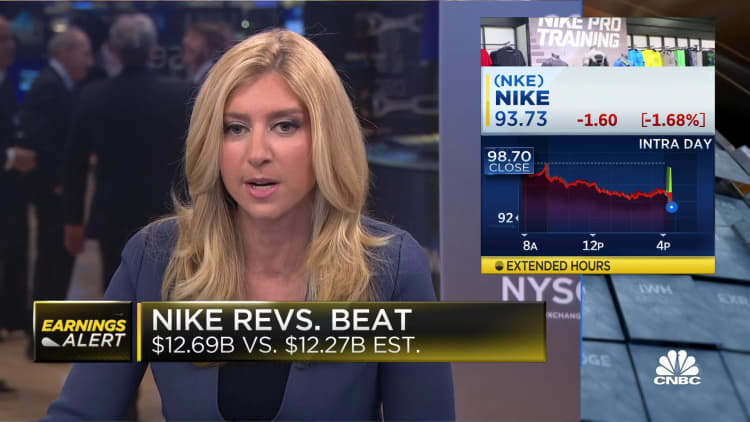Nike (NKE) earnings Q1 2023
A woman shops for shoes in the Nike Factory Store at the Outlet Shoppes at El Paso, in El Paso, Texas on November 26, 2021.
Paul Ratje | AFP | Getty Images
Nike on Thursday said it had a strong first fiscal quarter despite supply chain issues, as well as declining sales in Greater China, its third biggest market by revenue.
But Nike’s shares fell more than 10% Friday after the company described problems with overstocked inventory levels and the aggressive steps it’s taking to lower them.
Nike and other retailers have been facing supply chain headwinds, such as increases in shipping times and costs, and Covid-related store closure disruptions.
Here’s how Nike did in its first fiscal quarter compared with what Wall Street was anticipating, based on a survey of analysts by Refinitiv:
- Earnings per share: 93 cents vs. 92 cents expected
- Revenue: $12.69 billion vs. $12.27 billion expected
As delivery times and consumer demand rose this year, retailers responded by ordering inventory earlier than usual. When in-transit shipping time began to improve quickly, Nike CFO Matthew Friend said, it led to swelling inventories.
The Nike executive noted that this, mixed with consumers facing greater economic uncertainty, promotional activity has accelerated across the marketplace, especially for apparel brands.
“As a result, we face a new degree of complexity,” Friend said on the call with investors on Thursday, adding that Nike will look to clear inventory for specific pockets of “seasonally late products,” especially apparel.
Nike executives said its inventory in North America alone grew 65% compared to last year, reflecting a combination of late deliveries for the past two seasons and early holiday orders that are now scheduled to arrive earlier than planned.
That has been in having a few seasons’ worth of merchandise available at the same time. Because of that, Friend said, “we’ve decided to take that inventory and more aggressively liquidate it so that we can put the newest and best inventory in front of the consumer in the right locations.”
Nike reported net income for the three-month period ended Aug. 31 fell 22% to $1.5 billion, or 93 cents per share, compared with $1.87 billion, or $1.18 per share, a year earlier.
Revenue during the period was up 4% to $12.7 billion, compared with $12.2 billion a year earlier.
Recently, Nike has been shifting its strategy and looking to sell its sneakers and other merchandise directly to customers and scale back on what is sold by wholesale partners like Foot Locker. The company said on Thursday its direct sales grew by 8% to $5.1 billion, and sales for its digital-brand rose 16%. On the flip side, sales for Nike’s wholesale business sales increased by 1%.

In its first fiscal quarter, Nike said its inventory rose 44% to $9.7 billion on its balance sheet from the same period last year, which the company said was driven by supply chain issues and partially offset by strong consumer demand.
Total sales in Greater China were down 16% to about $1.7 billion, compared with nearly $2 billion a year earlier. The company has faced disruption in its business in the region, where Covid lockdowns have affected its business. Nike had said in the previous quarter it expected issues in Greater China to weigh on its business.
Meanwhile, total sales in North America, Nike’s largest market, increased 13% to $5.5 billion in the first fiscal quarter, compared with roughly $4.9 billion in the same period last year. The sneaker giant has continuously said consumer demand, especially in the US market, hasn’t waned despite inflation.
The company said Thursday it expects revenue in the second fiscal quarter to grow low double digits based on strong consumer demand, despite supply chain and foreign exchange currency headwinds.
Read the company’s earnings release here.